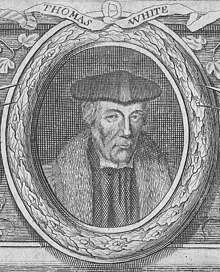Thomas White (dealer)

Sir Thomas White (* 1492 in Reading , Berkshire ; † February 12, 1567 in Gloucester Hall, Oxford University , Oxfordshire ) was an English textile merchant, Lord Mayor of London and founder of St John's College in Oxford and the Merchant Taylors' School in London .
Thomas White was the son of the draper William White of Rickmansworth, Hertfordshire and his wife Mary, the daughter of John Kebblewhite of South Fawley, Berkshire . At the age of twelve he was apprenticed to Hugh Acton, a prominent member of the Merchant Taylors' Company. After his master left him a modest legacy on his death in 1520, he went into business for himself in the cloth business in 1523 and ran the Merchant Taylors' Company in this capacity until around 1535 before he was able to acquire it.
Since then he has also acted as a benefactor. In 1542 and 1545 he granted major loans to the cities of Coventry and Bristol and supported the parish of St. Michael, Cornhill , of which he was a member and which elected him to council in 1544. In 1547 he became county bailiff. In 1561 he signed a trust agreement on behalf of his company in favor of the city of Coventry, which should receive generous funds for charitable and charitable purposes after his death. On October 2, 1553, he was in the presence of Queen Mary by the Earl of Arundel to the Knights defeated and thus elevated to the peerage. On October 29 of the same year he was appointed Lord Mayor of London. The splendor and pomp of the pageant on the occasion of his inauguration have been handed down. His time as mayor was marked by various proclamations and laws against gambling and dancing.
Also in 1553 he was a member of the judicial commission in the proceedings against Lady Jane Gray her followers.
After the end of this assignment, White focused on charitable projects outside the city. His friend, Sir Thomas Pope (1507–1559) had recently founded Trinity College in Oxford, which inspired him to found a college himself in the city where he already had lands. On May 1, 1555 he received royal permission to run a college "for the learning of the sciences of holy divinity, philosophy and good arts" ( for teaching the sciences of theology, philosophy and the fine arts ), that of the saints The Virgin Mary and St. John the Baptist (the patron saint of the Merchant Taylors' Company) should be dedicated.
In 1559 White acquired Gloucester Hall, where he spent the last years of his life. From 1562 he increasingly suffered from the crisis in the cloth industry and got into financial difficulties. Nonetheless, he was able to continue to set up various trust funds for the benefit of various cities, London drapery associations and his own relatives.
When White died on February 12, 1567, he was a poor man. Much of the money he donated to his college or other social causes never made it, but was used up by agents, trustees and other collaborators.
Sir Thomas was married twice. His first wife, Avicia, whose family name is unknown, died on February 26, 1558. On November 25 of the same year he married Joan, the daughter and co-heiress of John Lake of London and the widow of Sir Ralph Warren . He had no offspring.
Sir Thomas White is occasionally confused with his namesake Sir Thomas White of South Warnborough in Hampshire, who was raised to the nobility on the same day and whose wife was Agnes. The confusion is all the more understandable given that Thomas White's South Warnborough lands also ended up in the property of St John's College. However, this was due to a gift from Archbishop Laud , who received the lands from William Sandys in 1636 .
Web links
- David Nash Ford's Royal Berkshire History biography of Sir Thomas White
- Sir Thomas White Lord Mayof of London The Tudorplace website. Thomas White biography.
| personal data | |
|---|---|
| SURNAME | White, Thomas |
| BRIEF DESCRIPTION | English textile merchant, Lord Mayor of London, founder of St John's College, Oxford |
| DATE OF BIRTH | 1492 |
| PLACE OF BIRTH | Reading , Berkshire |
| DATE OF DEATH | February 12, 1567 |
| Place of death | Gloucester Hall, University of Oxford , Oxfordshire |
